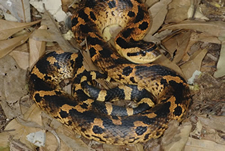General Information
This Web site refers to snakes typically found north of Interstate 85 in South Carolina, although it will apply to much of the piedmont region of the state.
The 21 snake species that are addressed in this Web site are listed in Table 1. They are a group of agile and colorful animals that range in adult size from 8 inches to over 5 feet. Depending on the species, they may go about their daily routines on forest floors, in forest canopies, under ground, in grassy fields and pastures, in old rock walls, along lake shores, and in other habitats of our area. Some live un-noticed in suburban gardens and others may spend considerable time in the backyard shade tree.
 Although all are “cold blooded” and are most active in the warmer months (April thru October), there is also considerable variation in how they approach life. Some eat rodents,
some eat fish, one eats crayfish, some dine on earthworms, and one lives largely on toads. Twelve of the species obtain their food by grabbing it and swallowing it alive, seven
species kill their prey by constriction prior to eating it (see Table 2), and two quickly kill their prey through their highly venomous bite.
Regarding reproduction, 13 species lay eggs (in late spring); while the eight others bear live young (in late summer) (see Table 3). And,
although most are totally silent, two can hiss very loudly, and one can noisily shake the rattle that grows on the end of its tail.
Although all are “cold blooded” and are most active in the warmer months (April thru October), there is also considerable variation in how they approach life. Some eat rodents,
some eat fish, one eats crayfish, some dine on earthworms, and one lives largely on toads. Twelve of the species obtain their food by grabbing it and swallowing it alive, seven
species kill their prey by constriction prior to eating it (see Table 2), and two quickly kill their prey through their highly venomous bite.
Regarding reproduction, 13 species lay eggs (in late spring); while the eight others bear live young (in late summer) (see Table 3). And,
although most are totally silent, two can hiss very loudly, and one can noisily shake the rattle that grows on the end of its tail.
They do fine without people, but occasionally the snake and the person meet up, sometimes suddenly. At that point various things happen. It is our hope that this Web site will help the reader gain an appreciation for the fact that what they have encountered is a species of our native wildlife, and that there is much of interest to be learned and appreciated about the animal at hand.
Several current books and Web sites provide good photos or illustrations of regional snakes that will be useful in helping to identify any specimens found in upstate South Carolina. Some of the most useful of these books include the following.
- A Field Guide To Reptiles And Amphibians Of Eastern And Central North America. 1998. By Roger Conant and Joseph T. Collins. Houghton Mifflin Co. NY. 616 p. For decades this book, and its earlier editions, has been a primary field guide to snakes and all reptiles and amphibians throughout the eastern US. Beautiful illustrations and identification aides. Cost approx $20.
- Amphibians and Reptiles of the Carolinas and Virginia. 1980. By Bernard S. Martof et al. UNC Press, Chapel Hill. 264 pages.
This book provides beautiful color photos of all the snakes that are found in South Carolina, including those known from the upstate. As its title indicates, it also covers the other reptiles (lizards, turtles, alligator) and all the amphibians (frogs/toads, salamanders) of South Carolina and the adjoining states. Cost: approx $23 - Snakes of the Southeast. 2005. By Whit Gibbons and Mike Dorcas. The University of Georgia Press, Athens and London. 253 pages.
Beautiful photos and interesting natural history information for all the snakes
that occur in the southeast, including those in upstate South Carolina.
Cost: Approximately $23 - Four interesting web sites that provide good color photos and general info about regional snakes, including those of upstate South Carolina are:
University of Georgia's Savannah River Ecology Laboratory (SREL)
www.snakesandfrogs.com
University of Georgia's Savannah River Ecology Laboratory (SREL)
If you find a snake in the upstate that you do not recognize, we suggest that using one, or more, of these sources, in combination with the information presented in this Web site, will help you identify it. For example, if you think you have seen an eastern kingsnake, look it up in one of these books by its common name or by its scientific name. Then compare the photo in the book to your specimen. Once you know what species you have, you can then read about it in more detail. However, if you cannot identify it, try to take a digital photo of it (without harming it or yourself) and send it to our DNR e-mail address provided in the last section of this Web site. We will attempt to identify it for you.
